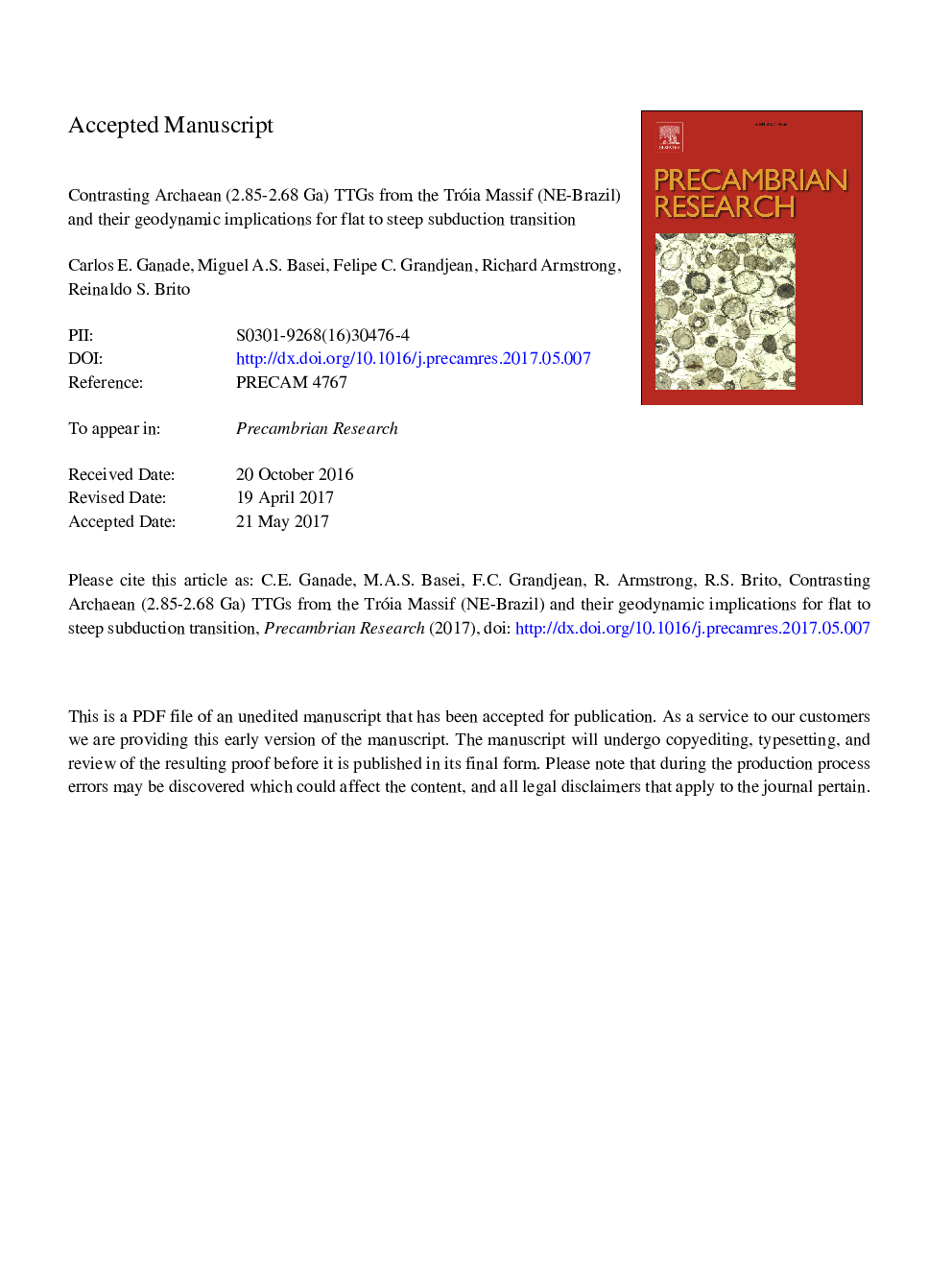| کد مقاله | کد نشریه | سال انتشار | مقاله انگلیسی | نسخه تمام متن |
|---|---|---|---|---|
| 5784743 | 1639578 | 2017 | 22 صفحه PDF | دانلود رایگان |
عنوان انگلیسی مقاله ISI
Contrasting Archaean (2.85-2.68Â Ga) TTGs from the Tróia Massif (NE-Brazil) and their geodynamic implications for flat to steep subduction transition
دانلود مقاله + سفارش ترجمه
دانلود مقاله ISI انگلیسی
رایگان برای ایرانیان
کلمات کلیدی
موضوعات مرتبط
مهندسی و علوم پایه
علوم زمین و سیارات
ژئوشیمی و پترولوژی
پیش نمایش صفحه اول مقاله

چکیده انگلیسی
We present field, U-Pb zircon geochronology and geochemical data from grey gneisses and amphibolites from Tróia Massif of Northern Borborema Province, NE-Brazil. U-Pb zircon dating of the gneisses indicate two different episodes of Archaean crust formation, represented by the Mombaça (2.85-2.77Â Ga) and Pedra Branca (2.70-2.68Â Ga) units. Gneisses from Mombaça unit have high content of SiO2 (64.4-75.4Â wt.%), Na2O (3.28-5.01Â wt.%), Al2O3 (13.7-17.2Â wt.%) and low MgO (0.24-2.60Â wt.%) and âHREE combined with (La/Yb)N ratios varying from 6 to 118. In general, these geochemical features are in agreement with patterns of Archaean TTGs younger than 3.5Â Ga and high-silica adakites, generated by partial melting of hydrous mafic rocks having garnet as a residual phase. Although high-SiO2 samples of the Pedra Branca grey gneisses have similar geochemical characteristics to those of Mombaça unit, most samples have higher values of MgO, Sr and compatible elements (Ni-Co) indicating contrasting sources and/or petrogenesis, and thus should be referred to TTG-like gneisses. The lower SiO2 content of the Pedra Branca TTG-like gneisses coupled with higher values of MgO, Ni, and Co preclude direct melting of meta-mafic rocks, but is suggestive of interaction with peridotitic mantle components. The Mombaça TTGs are better classified as medium-pressure TTGs derived from melting of a garnet-rich, but plagioclase-poor amphibolite. We argue that the higher geothermal gradient required for the formation of these medium-pressure TTGs could be achieved in a flat subduction setting, explaining not only the its geochemical features but also the absence of a constituted mantle wedge. The residual garnet within the subducting slab coupled with eclogitization would raise the density and trigger the slab retreatment and deepening the subduction zone. This would allow the formation of an incipient mantle wedge, and continuous TTG magmatism would fertilize the mantle, that was subsequently involved in the petrogenesis of the younger Pedra Branca unit. Mafic dykes with E-MORB composition yielded a Paleoproterozoic age at ca. 2.03Â Ga with inherited zircons from the host gneiss at ca. 2.85Â Ga, indicating thus no relation with TTG magmatism.
ناشر
Database: Elsevier - ScienceDirect (ساینس دایرکت)
Journal: Precambrian Research - Volume 297, August 2017, Pages 1-18
Journal: Precambrian Research - Volume 297, August 2017, Pages 1-18
نویسندگان
Carlos E. Ganade, Miguel A.S. Basei, Felipe C. Grandjean, Richard Armstrong, Reinaldo S. Brito,